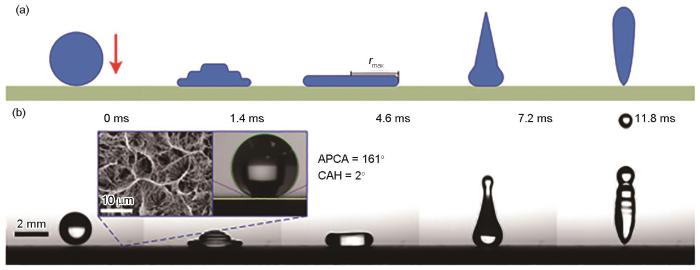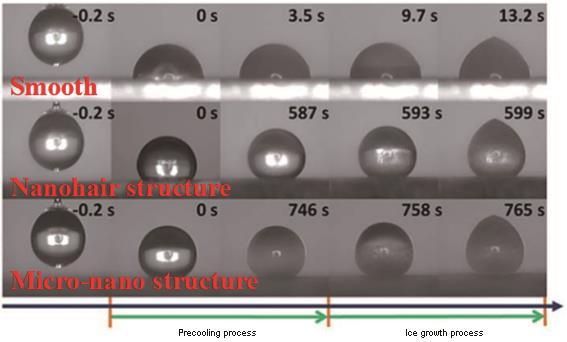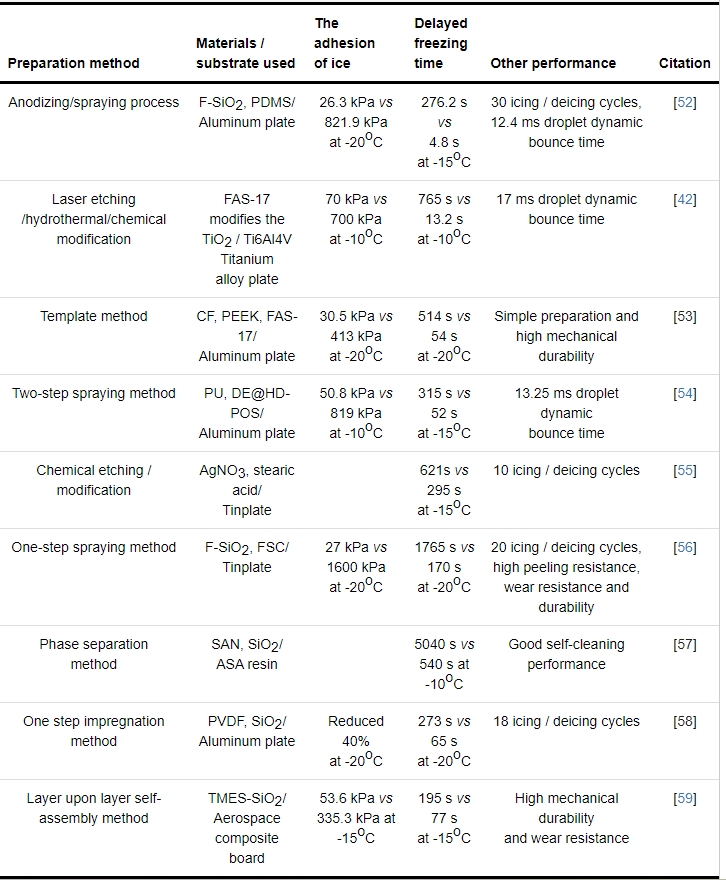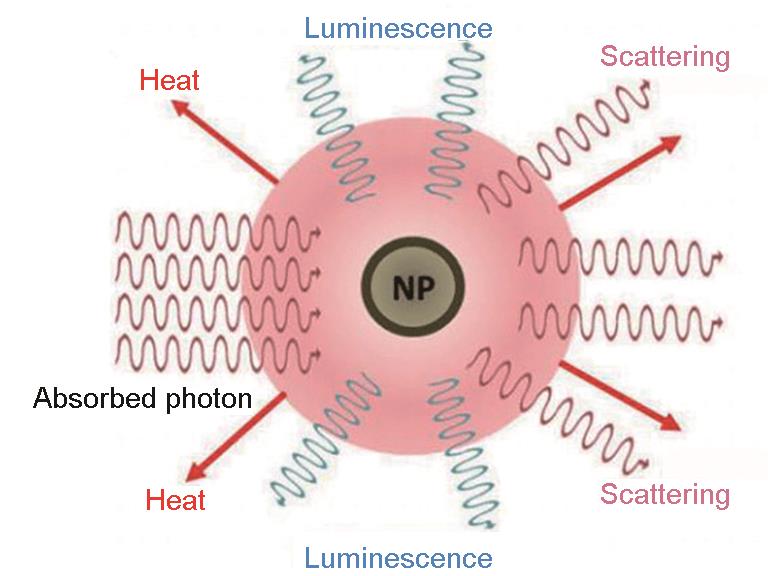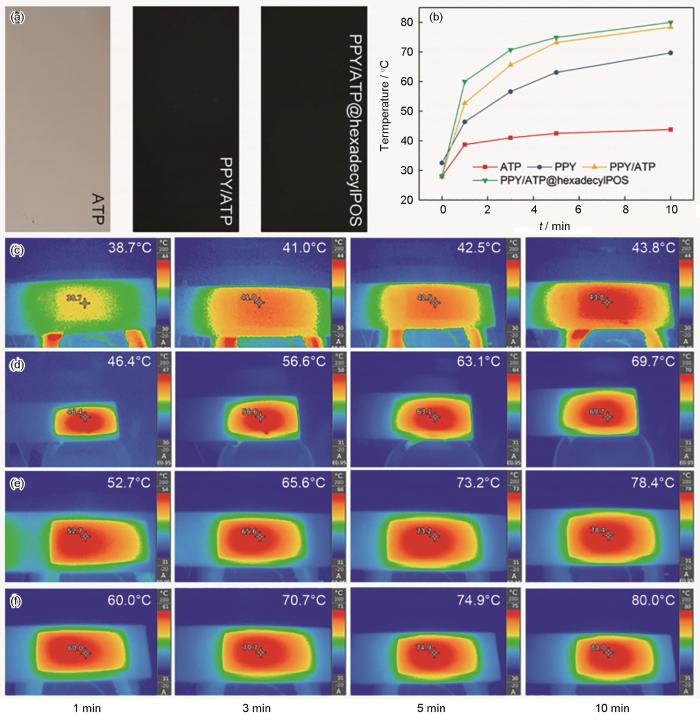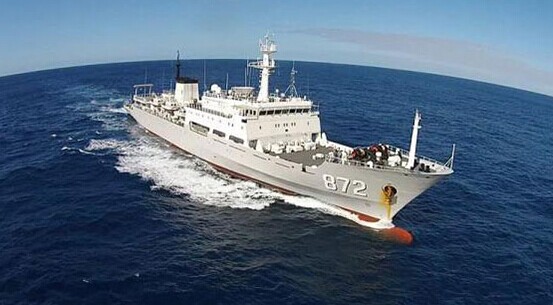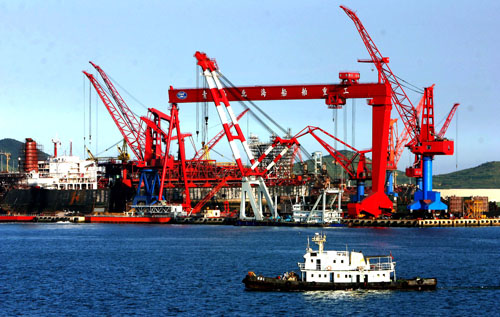1.4 超疏水界面的抗冰特性
對于超疏水的抗冰特性可以從3個角度思考,即去除動態(tài)水滴、控制晶核形成和降低冰的附著力。通常水滴是以動態(tài)的方式滴落到固體表面,對于高靜態(tài)接觸角、低動態(tài)接觸角滯后的超疏水表面(Cassie-Baster狀態(tài)),水滴滴落至表面時會發(fā)生反彈或者滾落,極大的減少了接觸時間,避免了低溫下水滴與表面接觸并產(chǎn)生結(jié)冰。因此,動態(tài)的抗冰特性可以通過液滴在樣品表面的撞擊接觸時間和接觸過程來評價。對于具有低接觸角滯后的超疏水表面,在微納米表面結(jié)構(gòu)之間存在大量的氣袋。空氣可以有效地充當(dāng)超疏水表面和水滴之間的熱屏障,令水滴與表面之間的相互作用較弱,水滴仍然保持球形,從而使液滴與表面的接觸面積最小。通過這種方式,水滴很容易被外力推離表面,從而防止它們被凍結(jié)[36~38]。對于親水表面,液滴撞擊到表面會出現(xiàn)潤濕表面的情況;對于疏水表面,液滴撞擊表面的過程見圖3,撞擊的過程可分為4個時間點(diǎn):接觸時刻、最大鋪展時刻、最大延伸時刻(從冠狀形成開始)和脫離表面時刻[39]。在這樣一個極疏水的表面液滴的最小撞擊時間可達(dá)到12 ms,接觸時間取決于液體的性質(zhì)、表面的潤濕性和水滴的運(yùn)動學(xué)參數(shù)。
圖3 水滴(初始直徑D0 = 2 mm,沖擊速度V0 =1 m·s-1)對超疏水表面的撞擊過程示意圖[39]
當(dāng)液滴停留在固體表面,隨著溫度的降低,在0℃左右會很快發(fā)生結(jié)冰。如前所述,在日常環(huán)境中所見結(jié)冰現(xiàn)象基本是非均勻形核,在冰晶形核過程中,當(dāng)突破自由能壘后晶核會穩(wěn)定并很快成長成冰。超疏水材料具有抑制晶核形成的特性,主要體現(xiàn)為降低液滴結(jié)冰溫度和延長液滴結(jié)冰時間[23]。Cassie-Baster潤濕模型下的超疏水表面,其存在的微納米分層的粗糙結(jié)構(gòu)有利于捕獲液滴下面的氣袋。空氣相比固體表面?zhèn)鳠嵝实秃芏啵且环N很好的保溫層,減緩了水滴和基體間的熱交換,這種熱屏障可以降低液滴的過冷程度,從而降低液滴的結(jié)冰溫度。同時根據(jù)經(jīng)典形核理論,接觸角越大,冰核形成的自由能壘越大,較大的靜態(tài)接觸角也減少了液滴和表面的接觸面積,減少了形核位置和概率,最終使得形核速率變慢,形核難度變大,從而延緩了液滴的結(jié)冰時間[40, 41]。Shen等[42]在金屬襯底上制備了微尺度規(guī)則陣列和納米毛層次結(jié)構(gòu),并用含氟硅烷進(jìn)行修飾后獲得超疏水表面,研究表明超疏水表面可以延遲結(jié)冰時間達(dá)到765 s,對晶核的形成有明顯的抑制作用,見圖4。微納米結(jié)構(gòu)的超疏水表面相比納米結(jié)構(gòu)的超疏水表面延遲結(jié)冰時間更長,可見微納米結(jié)構(gòu)在抗冰作用中是非常重要的。
圖4 在光滑、納米結(jié)構(gòu)和微納米結(jié)構(gòu)的金屬表面上的冰形成過程光學(xué)圖像[42]
在低溫下,對于長時間停留在表面的液滴總是會發(fā)生結(jié)冰,具有低的冰附著力的表面可以便于借助外力使冰從表面脫落,減少覆冰。冰在固體材料表面的強(qiáng)粘附性在很大程度上是由于極性冰分子和固體分子之間的強(qiáng)相互作用,這通常是由氫鍵、范德華力和直接靜電相互作用引起的[43, 44]。研究表明[16],Cassie-Baster狀態(tài)下的超疏水表面具有低的冰附著力。它會將空氣儲存在分層的微納米結(jié)構(gòu)中,在一定載荷下,空氣提供足量的空隙,減少了冰與表面的接觸面積和冰分子與固體分子之間的直接靜電相互作用,達(dá)到降低粘附強(qiáng)度的效果。冰的粘附強(qiáng)度可以通過剪切或拉伸粘附試驗(yàn)來表征,但由于目前沒有形成冰粘附試驗(yàn)的標(biāo)準(zhǔn)文件,研究人員均采用自行搭建的設(shè)備進(jìn)行實(shí)驗(yàn)。
2 基于超疏水的功能性抗冰涂層的研究進(jìn)展
自從發(fā)現(xiàn)超疏水材料具有抗冰作用后,研究人員開發(fā)了大量以超疏水為基礎(chǔ)的抗冰涂層。然而,超疏水涂層的抗冰性能受到諸多內(nèi)外因素的影響,探索解決現(xiàn)存問題的新方法尤為重要。近年來將不同技術(shù)、不同材料和超疏水結(jié)合在一起的新方向引起了廣泛關(guān)注,如利用光熱、電熱等技術(shù)與超疏水結(jié)合在一起形成的多功能化抗冰涂層,這也是拓寬抗冰超疏水涂層的重要思路。基于此,本部分對這些技術(shù)和材料進(jìn)行了歸納總結(jié)。
2.1 超疏水涂層
超疏水涂層具有優(yōu)異的抗冰性能,正成為目前的研究熱點(diǎn)。構(gòu)成超疏水表面的條件是低表面能表面和微納米粗糙結(jié)構(gòu),制備方法通常可分為兩類:一類是典型的多步法,通常包括在低表面能表面構(gòu)造微納米粗糙度和先在表面構(gòu)造粗糙結(jié)構(gòu)再通過低表面能物質(zhì)化學(xué)改性,具體技術(shù)有刻蝕法、沉積法、模板法、溶膠-凝膠法和層層自組裝法等[17, 45~47];另一類是一步法,通過在低表面能物質(zhì)成膜過程同時形成表面粗糙度,構(gòu)造出微納米結(jié)構(gòu)的超疏水表面,具體技術(shù)有原位生成法、相分離法和一步噴涂法等[48~50]。如Lo等先通過化學(xué)刻蝕和水熱法在Al表面制備出微納米結(jié)構(gòu),然后將聚二甲基硅氧烷-三乙氧基硅烷(PDMS-TES)和全氟癸基三乙氧基硅烷(FD-TMS)以不同的比例混合修飾到微納米結(jié)構(gòu)表面上,PDMS-TES與鋁表面為共價鍵結(jié)合可以提高涂層耐久性。對冰附著力和延遲結(jié)冰時間進(jìn)行評估表明,即使在100次結(jié)冰/融化循環(huán)后,其對冰的粘附強(qiáng)度也能低至47 kPa[51]。
以各種超疏水抗冰涂層制備方法為基礎(chǔ),對所用材料、冰的附著力和延時結(jié)冰時間等進(jìn)行總結(jié)和歸納,具體內(nèi)容見表1。
表1 超疏水抗冰涂層的制備方法及各項(xiàng)性能表征總結(jié)
2.2 功能性光熱/超疏水涂層
為擴(kuò)展超疏水涂層的實(shí)際應(yīng)用,近年來研究人員發(fā)展了一種新型的主動除冰和被動抗冰策略,在同時具有疏水性和光熱功能的超疏水涂層方向進(jìn)行了大量研究,最大限度的提高了抗冰效果。
光熱材料的概念來自于太陽能集熱和醫(yī)學(xué)上的光熱療法,是指材料在吸收太陽光能量的同時自身可以發(fā)出足量的熱量。太陽輻射的光譜范圍很寬,而能量主要集中在0.25~2.5 μm之間,當(dāng)太陽光束照射在光熱材料表面時,一些入射光子會被其散射,而其他光子則會被吸收,被吸收的光子負(fù)責(zé)產(chǎn)生熱[60, 61],作用過程見圖5。為了確保較大的光熱轉(zhuǎn)換效率,需要具有大吸收效率和低發(fā)光量子產(chǎn)率的光熱納米材料(NP)[62]。
圖5 光熱材料光照生熱過程原理
目前應(yīng)用在光熱涂層中的材料可分為金屬納米材料、碳結(jié)構(gòu)材料和有機(jī)納米材料(導(dǎo)電聚合物)等。不同材料由于其結(jié)構(gòu)和性質(zhì)不同,光熱機(jī)制也是不一樣的。金屬納米材料的光熱機(jī)制與納米顆粒和入射光發(fā)生表面等離子體共振作用有關(guān),熱量是由表面電流通過發(fā)熱產(chǎn)生的弛豫產(chǎn)生的。碳結(jié)構(gòu)材料的光熱機(jī)制與π等離子共振有關(guān)(這種等離子體與碳原子之間的π鍵有關(guān),屬于光誘導(dǎo)的集體電荷運(yùn)動)。導(dǎo)電聚合物的光熱機(jī)制與光誘導(dǎo)載流子電流的弛豫有很大關(guān)系[62, 63]。Xie等[64]通過將PPY/ATP@hexadecylPOS懸浮液和有機(jī)硅樹脂的混合物噴涂到Al板上制備出一種高效無氟、抗冰的光熱超疏水涂層。研究表明,PPY/ATP@hexadecylPOS涂層在一個太陽光照下相比而言有最高的光熱轉(zhuǎn)換溫度,10 min可升至最高溫度80℃,見圖6。而且在-10℃環(huán)境下對水滴延時結(jié)冰時間達(dá)330 s,在一個太陽下同樣的環(huán)境延時結(jié)冰時間可達(dá)600 s,在-10℃冰的附著力只有51.6 kPa。文中的模擬室外環(huán)境研究表明該涂層有非常快的光熱除冰和長效的抗冰性能[64]。
圖6 ATP、PPY/ATP和PPY/ATP@十六烷基POS涂層和其在1個太陽光照下的表面溫度隨照射時間的變化,以及相應(yīng)的ATP、PPY、PPY/ATP和PPY/ATP@十六烷基POS涂層在一定時間間隔內(nèi)的紅外圖像[64]
基于此,對目前光熱超疏水多功能涂層的制備方法、材料、冰的附著力和延時結(jié)冰時間等性能進(jìn)行總結(jié)和歸納,具體內(nèi)容如表2所示。
表2 光熱超疏水抗冰涂層的各項(xiàng)性能表征總結(jié)
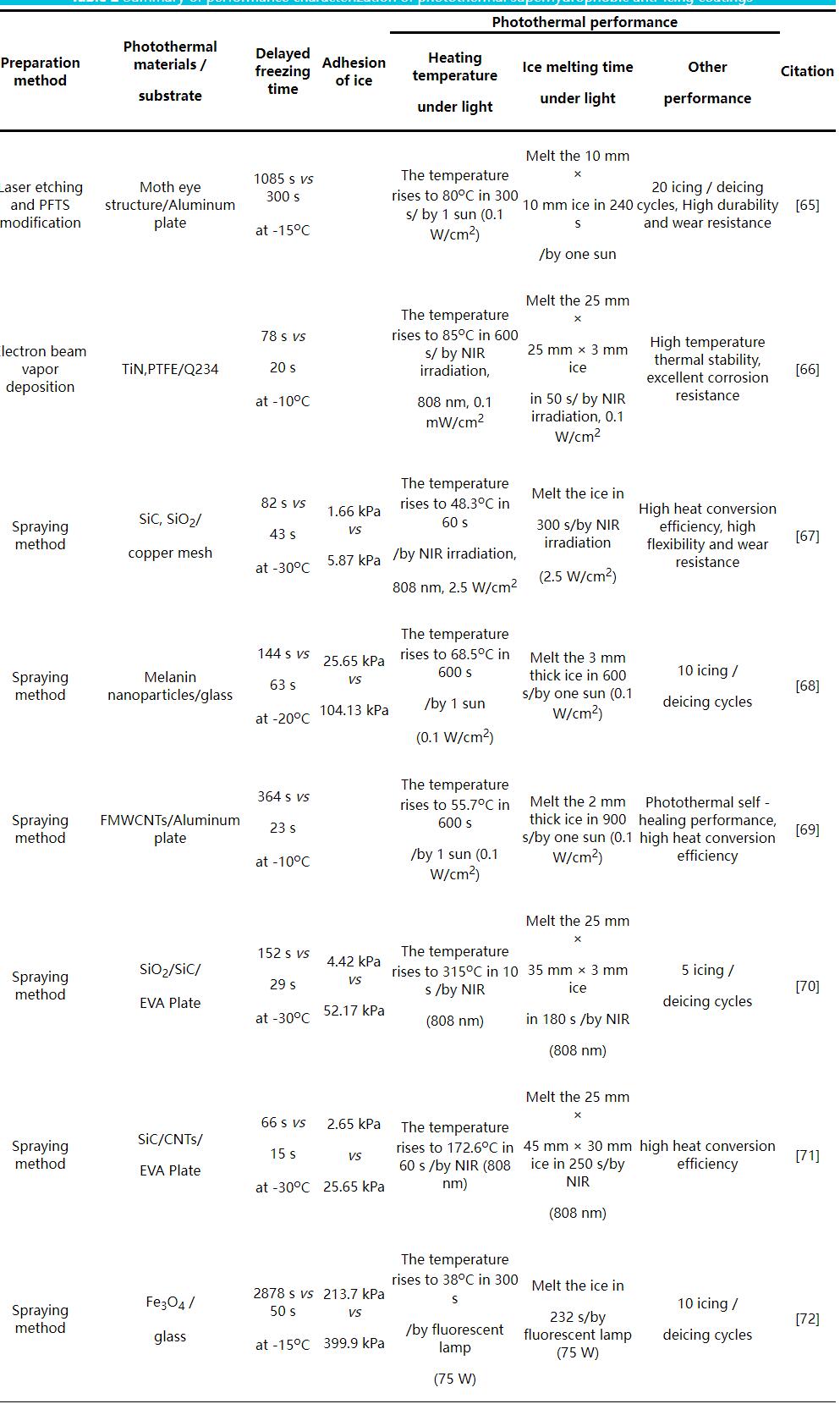
2.3 功能性電熱/超疏水涂層
電熱系統(tǒng)是一種廣泛應(yīng)用于飛機(jī)、電纜的主動防除冰策略,通過在表面制備嵌入式的電加熱元件或者導(dǎo)電復(fù)合材料,接通電源后,會產(chǎn)生焦耳熱量并以熱傳導(dǎo)、熱對流和熱輻射的方式傳輸熱量,見圖7,可達(dá)到防除冰的效果,其具有高效率、高可控性等特點(diǎn),如波音和空客都應(yīng)用這種技術(shù)來進(jìn)行防除冰[73]。作為電熱系統(tǒng)中的重要一環(huán),導(dǎo)電復(fù)合材料得到了廣泛的關(guān)注和大量的研究。近年來,具有優(yōu)異電子流動性的碳材料及其衍生物成為導(dǎo)電復(fù)合材料的研究熱點(diǎn),如碳納米管(CNTs)[74~76],高度排列的碳納米網(wǎng)[77]、石墨烯[78]、石墨烯納米帶(GNP)[79]、石墨納米片(GNR)[80]、碳纖維(CF)[81]等。如將電熱復(fù)合材料和超疏水涂層結(jié)合在一起,利用超疏水涂層優(yōu)異的防冰性能,輔以電熱系統(tǒng)進(jìn)行結(jié)冰后的除冰,既可以減少能量消耗,又提高了防除冰的效果。
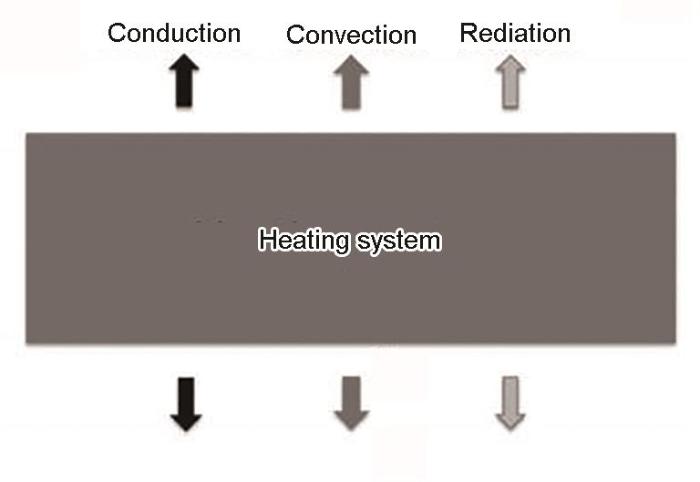
圖7 焦耳熱傳遞示意過程
具有優(yōu)異電學(xué)性能的CNTs是碳材料中應(yīng)用最廣泛的一種,將其與超疏水結(jié)構(gòu)結(jié)合得到被動防冰和主動除冰的綜合效果是研究人員的關(guān)注熱點(diǎn)[82~85]。Chu等提出了一種重量輕、超疏水性、耐久性強(qiáng)、具有電熱除冰性能的石墨烯基(FSGF-T200)薄膜,研究表明,F(xiàn)SGF-T200薄膜不但對水滴延時結(jié)冰可以延長至8倍左右,而且對冰的附著力可以降低至原先的0.2倍。此外,F(xiàn)SGF-T200薄膜也具有較好的電熱性能,在15 V電壓下可以在20 s內(nèi)迅速升溫到62.2℃,而且溫度分布是均勻的。除霜和除冰實(shí)驗(yàn)發(fā)現(xiàn),在15 V電壓下FSGF-T200薄膜30 s內(nèi)可以完全除霜,20 s內(nèi)可以讓冰層融化滑動,見圖8[86]。
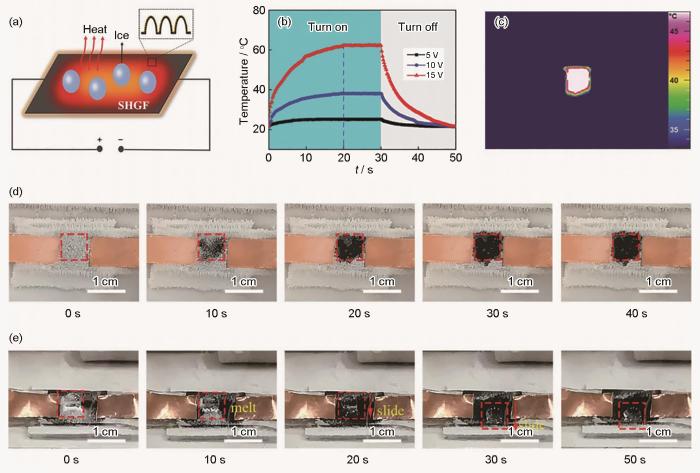
圖8 FSGF-T200薄膜的電熱除冰原理,在不同施加電壓下的焦耳加熱曲線和施加15 V直流電壓后FSGF-T200的紅外圖像,除霜與除冰過程[86]
電熱材料具有高效的除冰、解凍效率,但是往往會存在功耗大的問題,將其與超疏水技術(shù)結(jié)合在一起,可以達(dá)到一體化防冰和除冰的效果,發(fā)展高靈活度、高耐久性和低功耗的電熱超疏水材料和技術(shù)也是未來抗冰涂層的一個重要研究方向。
2.4 其他復(fù)合功能性超疏水涂層
目前有較深入研究的功能性材料包括對有磁性的材料添加磁場誘導(dǎo)其生熱,通過陽光和電壓對同時具備電熱光熱的材料誘導(dǎo)其生熱,作用過程見圖9。在研究超疏水抗冰涂層材料的過程中,科研人員也發(fā)現(xiàn)將這些具有磁性的材料和同時具有光熱、電熱的材料等與超疏水結(jié)構(gòu)結(jié)合在一起會有更好的抗冰效果,對開拓超疏水涂層的應(yīng)用具有更重要的意義,也將成為未來的研究熱點(diǎn)。
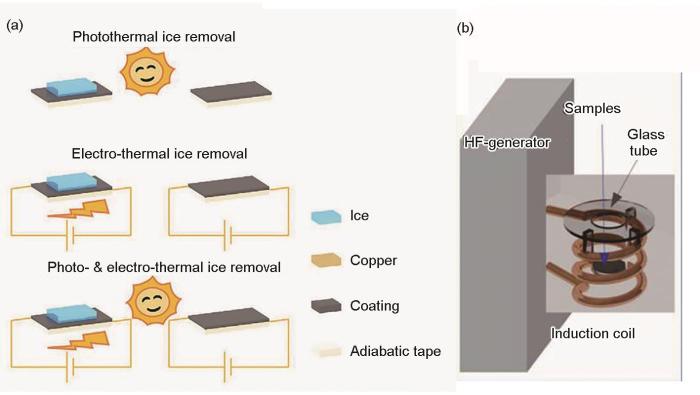
圖9 涂層光生熱、電生熱、光電生熱和磁生熱作用過程
磁性納米材料不但具有從光中吸收能量的性能,而且能夠在外部交流磁場下產(chǎn)生自加熱。可以將其光熱和磁熱效應(yīng)的主動除冰策略與超疏水性能的被動抗冰策略相結(jié)合,制備出性能優(yōu)異的抗冰涂層[72,87]。如Cheng等[72]制備出氨基功能化的磁性Fe3O4納米顆粒,并與氟化聚合物進(jìn)行交聯(lián)形成功能化的涂層,研究發(fā)現(xiàn)目標(biāo)涂層具有良好的超疏水性和潤濕穩(wěn)定性,超疏水表面可以將凍結(jié)時間從50 s延遲到2878 s,且對冰的粘附強(qiáng)度明顯低于純共聚物涂層。磁性Fe3O4的摻入對雜化薄膜帶來了明顯的磁場誘導(dǎo)加熱特性,摻雜含量最多的組分在25 s可以升溫至20℃以上。
將光熱和電熱效應(yīng)的主動除冰策略與超疏水性能的被動抗冰策略相結(jié)合也是未來功能化抗冰涂層的一個創(chuàng)新應(yīng)用方向。如Liu等采用噴涂法制備了一種由導(dǎo)電碳納米管(ECNTs)和氟改性聚丙烯酸酯組成的光熱@電熱超疏水涂層(PESC),同時實(shí)現(xiàn)了防冰和除冰的效果。PESC在1.2個太陽光照下溫度能達(dá)到18.6℃;當(dāng)施加15 V電壓時溫度也可以達(dá)到42.3℃(圖3.6b);對于在-30℃下有水滴的涂層表面,將陽光照明增加到0.8太陽,或電壓提高到10.5 V,水滴不會出現(xiàn)結(jié)冰[88],見圖10。
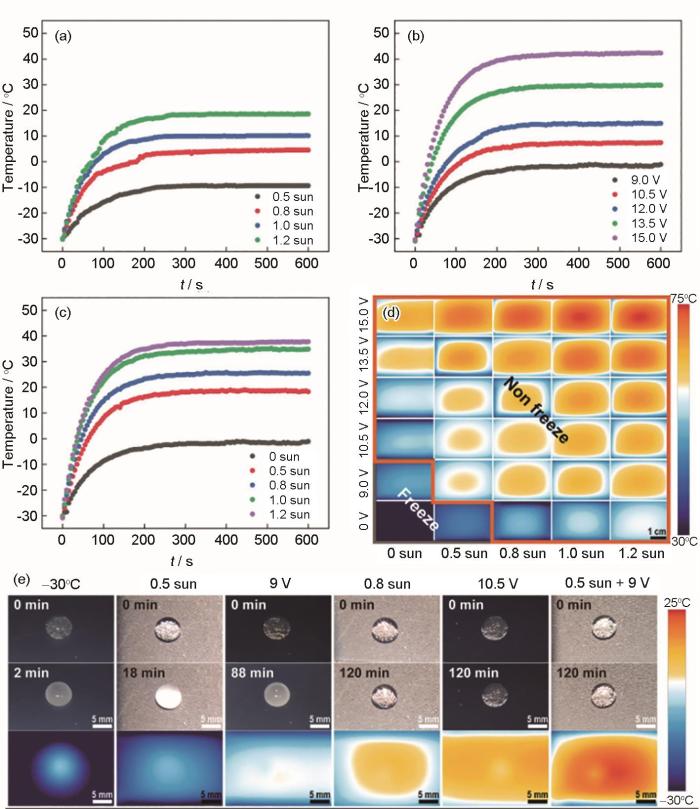
圖10 PESC涂層在施加不同光強(qiáng)下的光照生熱曲線,在施加不同電壓下的焦耳生熱曲線,在9.0 V電壓下施加不同光強(qiáng)下的生熱曲線,在同時施加不同電壓和光強(qiáng)下的紅外圖像,在施加不同電壓和光強(qiáng)下的水滴結(jié)冰過程和紅外圖[88]
3 總結(jié)與展望
自然界中常見的結(jié)冰現(xiàn)象,對人們的生活會產(chǎn)生很大影響,更重要的是對船舶、航空、電力等行業(yè)會造成嚴(yán)重的危害和損失。究其原理,結(jié)冰過程是在驅(qū)動力的作用下,隨機(jī)自發(fā)形成不穩(wěn)定的晶核,當(dāng)晶核達(dá)到一個臨界尺寸(超過了活化勢能)就能夠穩(wěn)定存在并不斷膨脹,最終導(dǎo)致整個體系的結(jié)晶。
超疏水涂層可以延緩這樣的結(jié)冰過程,從而使得其在抗冰領(lǐng)域得到了廣泛的應(yīng)用。這與超疏水本身的低表面能物質(zhì)和微納米粗糙度結(jié)構(gòu)有密切關(guān)系,事實(shí)上對于超疏水結(jié)構(gòu),也有Young、Wenzel和Cassie-Baster等幾種不同的潤濕狀態(tài),這對其性能會產(chǎn)生很大影響。對于超疏水的抗冰特性可以分為三個角度,即動態(tài)水滴的去除、晶核形成的控制和冰附著力的降低。然而超疏水涂層表面存在微納米粗糙度結(jié)構(gòu)容易被破壞,低表面能物質(zhì)與基質(zhì)的粘附力不強(qiáng)的缺陷,這使得其應(yīng)用受到了一定程度的限制。結(jié)合已經(jīng)成熟應(yīng)用的電熱、光熱除冰技術(shù),將此類主動除冰技術(shù)與被動抗冰的超疏水材料結(jié)合在一起,是一種非常有潛力有應(yīng)用價值的抗冰策略。目前該方向研究的主要有電熱超疏水涂層、光熱超疏水涂層、電熱+光熱+超疏水涂層以及其他一些功能化的超疏水涂層。
總的來說,超疏水涂層在抗冰領(lǐng)域具有很大的應(yīng)用價值,特別是功能化的超疏水涂層可以達(dá)到防冰和除冰的協(xié)同效果,可為極地船舶運(yùn)輸和科研考察等提供高效的抗冰解決方案。與此同時,制備方便、快速、低成本、對人體無毒和環(huán)境友好的超疏水抗冰涂層也是目前迫切需要解決的問題。盡管超疏水涂層將花費(fèi)很長時間來實(shí)現(xiàn)其在工業(yè)領(lǐng)域的廣泛應(yīng)用,但這是值得我們研究和探索的。
參考文獻(xiàn)
1 Alizadeh A, Yamada M, Li R, et al. Dynamics of ice nucleation on water repellent surfaces [J]. Langmuir, 2012, 28: 3180
doi: 10.1021/la2045256 pmid: 22235939
2 Norrstr?m A C, Bergstedt E. The impact of road de-icing salts (NaCl) on colloid dispersion and base cation pools in roadside soils [J]. Water Air Soil Poll., 2001, 127: 281
doi: 10.1023/A:1005221314856
3 Lv J Y, Song Y L, Jiang L, et al. Bio-inspired strategies for anti-icing [J]. ACS Nano, 2014, 8: 3152
doi: 10.1021/nn406522n pmid: 24592934
4 Feng L B, Yang M, Shi X T, et al. Copper-based superhydrophobic materials with long-term durability, stability, regenerability, and self-cleaning property [J]. Colloids Surf., 2016, 508A: 39
5 Wang C Z, Tang F, Li Q, et al. Spray-coated superhydrophobic surfaces with wear-resistance, drag-reduction and anti-corrosion properties [J]. Colloids Surf., 2017, 514A: 236
6 Fu S P, Sahu R P, Diaz E, et al. Dynamic study of liquid drop impact on supercooled cerium dioxide: anti-icing behavior [J]. Langmuir, 2016, 32: 6148
doi: 10.1021/acs.langmuir.6b00847
7 Pi P H, Hou K, Zhou C L, et al. Superhydrophobic Cu2S@Cu2O film on copper surface fabricated by a facile chemical bath deposition method and its application in oil-water separation [J]. Appl. Surf. Sci., 2017, 396: 566
doi: 10.1016/j.apsusc.2016.10.198
8 Zhang H F, Yin L, Li L, et al. Wettability and drag reduction of a superhydrophobic aluminum surface [J]. RSC Adv., 2016, 6: 14034
doi: 10.1039/C5RA23842K
9 Heinonen S, Huttunen-Saarivirta E, Nikkanen J P, et al. Antibacterial properties and chemical stability of superhydrophobic silver-containing surface produced by sol-gel route [J]. Colloids Surf., 2014, 453A: 149
10 Jung S, Tiwari M K, Doan N V, et al. Mechanism of supercooled droplet freezing on surfaces [J]. Nat. Commun., 2012, 3: 615
doi: 10.1038/ncomms1630 pmid: 22233625
11 Ling E J Y, Uong V, Renault-Crispo J S, et al. Reducing ice adhesion on nonsmooth metallic surfaces: wettability and topography effects [J]. ACS Appl. Mater. Interfaces, 2016, 8: 8789
doi: 10.1021/acsami.6b00187
12 Wang L, Wen M X, Zhang M Q, et al. Ice-phobic gummed tape with nano-cones on microspheres [J]. J. Mater. Chem., 2014, 2A: 3312
13 Zhang X, Shi F, Niu J, et al. Superhydrophobic surfaces: from structural control to functional application [J]. J. Mater. Chem., 2008, 18: 621
doi: 10.1039/B711226B
14 Ellinas K, Tserepi A, Gogolides E. Durable superhydrophobic and superamphiphobic polymeric surfaces and their applications: a review [J]. Adv. Colloid Interface Sci., 2017, 250: 132
15 Li S H, Huang J Y, Chen Z, et al. A review on special wettability textiles: theoretical models, fabrication technologies and multifunctional applications [J]. J. Mater. Chem., 2017, 5A: 31
16 Zhang S N, Huang J Y, Cheng Y, et al. Bioinspired surfaces with superwettability for anti-icing and ice-phobic application: concept, mechanism, and design [J]. Small, 2017, 13: 1701867
doi: 10.1002/smll.v13.48
17 Nguyen-Tri P, Tran H N, Plamondon C O, et al. Recent progress in the preparation, properties and applications of superhydrophobic nano-based coatings and surfaces: a review [J]. Prog. Org. Coat., 2019, 132: 235
doi: 10.1016/j.porgcoat.2019.03.042
18 Zeng Q H, Zhou H, Huang J X, et al. Review on the recent development of durable superhydrophobic materials for practical applications [J]. Nanoscale, 2021, 13: 11734
doi: 10.1039/d1nr01936h pmid: 34231625
19 Liu F T, Du H Z, Han Y, et al. Recent progress in the fabrication and characteristics of self-repairing superhydrophobic surfaces [J]. Adv. Mater. Interfaces, 2021, 8: 2100228
20 Webb H K, Hasan J, Truong V K, et al. Nature inspired structured surfaces for biomedical applications [J]. Curr. Med. Chem., 2011, 18: 3367
pmid: 21728964
21 Wang S T, Liu K S, Yao X, et al. Bioinspired surfaces with superwettability: new insight on theory, design, and applications [J]. Chem. Rev., 2015, 115: 8230
doi: 10.1021/cr400083y pmid: 26244444
22 Teisala H, Tuominen M, Kuusipalo J. Superhydrophobic coatings on cellulose-based materials: fabrication, properties, and applications [J]. Adv. Mater. Interfaces, 2014, 1: 1300026
doi: 10.1002/admi.v1.1
23 He H, Guo Z G. Superhydrophobic materials used for anti-icing Theory, application, and development [J]. iScience, 2021, 24: 103357
doi: 10.1016/j.isci.2021.103357
24 Li W, Zhan Y L, Yu S R. Applications of superhydrophobic coatings in anti-icing: Theory, mechanisms, impact factors, challenges and perspectives [J]. Prog. Org. Coat., 2021, 152: 106117
25 Kenzhebayeva A, Bakbolat B, Sultanov F, et al. A mini-review on recent developments in anti-icing methods [J]. Polymers, 2021, 13: 4149
doi: 10.3390/polym13234149
26 Gohari B, Russell K, Hejazi V, et al. Role of water solidification concepts in designing nano-textured anti-icing surfaces [J]. J. Phys. Chem., 2017, 121B: 7527
27 Zhang Z S, Liu X Y. Control of ice nucleation: freezing and antifreeze strategies [J]. Chem. Soc. Rev., 2018, 47: 7116
doi: 10.1039/c8cs00626a pmid: 30137078
28 Moore E B, Molinero V. Structural transformation in supercooled water controls the crystallization rate of ice [J]. Nature, 2011, 479: 506
doi: 10.1038/nature10586
29 Li Q, Guo Z G. Fundamentals of icing and common strategies for designing biomimetic anti-icing surfaces [J]. J. Mater. Chem., 2018, 6A: 13549
30 Lin N B, Liu X Y. Correlation between hierarchical structure of crystal networks and macroscopic performance of mesoscopic soft materials and engineering principles [J]. Chem. Soc. Rev., 2015, 44: 7881
doi: 10.1039/c5cs00074b pmid: 26214062
31 Liu X Y. Interfacial effect of molecules on nucleation kinetics [J]. J. Phys. Chem., 2001, 105B: 11550
32 Liu X Y, Maiwa K, Tsukamoto K. Heterogeneous two-dimensional nucleation and growth kinetics [J]. J. Chem. Phys., 1997, 106: 1870
33 Fletcher N H. Size effect in heterogeneous nucleation [J]. J. Chem. Phys., 1958, 29: 572
34 Liu X Y. A new kinetic model for three-dimensional heterogeneous nucleation [J]. J. Chem. Phys., 1999, 111: 1628
doi: 10.1063/1.479391
35 Schutzius T M, Jung S, Maitra T, et al. Physics of icing and rational design of surfaces with extraordinary icephobicity [J]. Langmuir, 2015, 31: 4807
doi: 10.1021/la502586a pmid: 25346213
36 Vandadi A, Zhao L, Cheng J T. Resistant energy analysis of self-pulling process during dropwise condensation on superhydrophobic surfaces [J]. Nanoscale Adv., 2019, 1: 1136
doi: 10.1039/c8na00237a pmid: 36133189
37 Liu B, Zhang K Q, Tao C, et al. Strategies for anti-icing: low surface energy or liquid-infused? [J]. RSC Adv., 2016, 6: 70251
doi: 10.1039/C6RA11383D
38 Barthwal S, Lim S H. Rapid fabrication of a dual-scale micro-nanostructured superhydrophobic aluminum surface with delayed condensation and ice formation properties [J]. Soft Matter, 2019, 15: 7945
doi: 10.1039/c9sm01256g pmid: 31544192
39 Shen Y, Tao J, Tao H, et al. Approaching the theoretical contact time of a bouncing droplet on the rational macrostructured superhydrophobic surfaces [J]. Appl. Phys. Lett., 2015, 107: 111604
40 Liu W P, Wang C M, Zhang L J, et al. Exfoliation of amorphous phthalocyanine conjugated polymers into ultrathin nanosheets for highly efficient oxygen reduction [J]. J. Mater. Chem., 2019, 7A: 3112
41 Yin Z Z, Xue M S, Luo Y D, et al. Excellent static and dynamic anti-icing properties of hierarchical structured ZnO superhydrophobic surface on Cu substrates [J]. Chem. Phys. Lett., 2020, 755: 137806
doi: 10.1016/j.cplett.2020.137806
42 Shen Y Z, Tao J, Tao H J, et al. Superhydrophobic Ti6Al4V surfaces with regular array patterns for anti-icing applications [J]. RSC Adv., 2015, 5: 32813
doi: 10.1039/C5RA01365H
43 Jia Z F, Shen Y Z, Tao J, et al. Understanding the solid-ice interface mechanism on the hydrophobic nano-pillar structure epoxy surface for reducing ice adhesion [J]. Coatings, 2020, 10: 1043
doi: 10.3390/coatings10111043
44 Zhang Y F, Zhang L Q, Xiao Z, et al. Fabrication of robust and repairable superhydrophobic coatings by an immersion method [J]. Chem. Eng. J., 2019, 369: 1
doi: 10.1016/j.cej.2019.03.021
45 Shen Y Z, Wang G Y, Zhu C L, et al. Petal shaped nanostructures planted on array micro-patterns for superhydrophobicity and anti-icing applications [J]. Surf. Coat. Technol., 2017, 319: 286
46 Jin H Y, Nie S C, Li Y F, et al. Investigation of the static icing property for super-hydrophobic coatings on aluminium [J]. Mater. Tehnol., 2017, 51: 789
doi: 10.17222/mit
47 Qian C L, Li Q, Chen X M. Droplet impact on the cold elastic superhydrophobic membrane with low ice adhesion [J]. Coatings, 2020, 10: 964
doi: 10.3390/coatings10100964
48 Luo Z Z, Zhang Z Z, Wang W J, et al. Various curing conditions for controlling PTFE micro/nano-fiber texture of a bionic superhydrophobic coating surface [J]. Mater. Chem. Phys., 2010, 119: 40
doi: 10.1016/j.matchemphys.2009.07.039
49 Luo Z Z, Zhang Z Z, Hu L T, et al. Stable bionic superhydrophobic coating surface fabricated by a conventional curing process [J]. Adv. Mater., 2008, 20: 970
doi: 10.1002/adma.v20:5
50 Lin Y B, Chen H F, Wang G Y, et al. Recent progress in preparation and anti-icing applications of superhydrophobic coatings [J]. Coatings, 2018, 8: 208
doi: 10.3390/coatings8060208
51 Lo T N H, Lee J, Hwang H S, et al. Nanoscale coatings derived from fluoroalkyl and PDMS alkoxysilanes on rough aluminum surfaces for improved durability and anti-icing properties [J]. ACS Appl. Nano Mater., 2021, 4: 7493
doi: 10.1021/acsanm.1c01526
52 Shen Y Z, Wu Y, Tao J, et al. Spraying fabrication of durable and transparent coatings for anti-icing application: dynamic water repellency, icing delay, and ice adhesion [J]. ACS Appl. Mater. Interfaces, 2019, 11: 3590
doi: 10.1021/acsami.8b19225
53 Pan L, Wang F, Pang X F, et al. Superhydrophobicity and anti-icing of CF/PEEK composite surface with hierarchy structure [J]. J. Mater. Sci., 2019, 54: 14728
doi: 10.1007/s10853-019-03956-0
54 Xie H, Zhao X, Li B C, et al. Waterborne, non-fluorinated and durable anti-icing superhydrophobic coatings based on diatomaceous earth [J]. New J. Chem., 2021, 45: 10409
doi: 10.1039/D1NJ01307F
55 Li K Q, Zeng X R, Li H Q, et al. A study on the fabrication of superhydrophobic iron surfaces by chemical etching and galvanic replacement methods and their anti-icing properties [J]. Appl. Surf. Sci., 2015, 346: 458
56 Wu Y L, She W, Shi D A, et al. An extremely chemical and mechanically durable siloxane bearing copolymer coating with self-crosslinkable and anti-icing properties [J]. Composites, 2020, 195B: 108031
57 Qi Y L, Yang Z B, Chen T T, et al. Fabrication of superhydrophobic surface with desirable anti-icing performance based on micro/nano-structures and organosilane groups [J]. Appl. Surf. Sci., 2020, 501: 144165
doi: 10.1016/j.apsusc.2019.144165
58 Tan X Y, Huang Z T, Jiang L H, et al. A simple fabrication of superhydrophobic PVDF/SiO2 coatings and their anti-icing properties [J]. J. Mater. Res., 2021, 36: 637
59 Tong W, Xiong D S, Wang N, et al. Mechanically robust superhydrophobic coating for aeronautical composite against ice accretion and ice adhesion [J]. Composites, 2019, 176B: 107267
60 Ding Z, Qi C, Wang Y X, et al. Spectrally selective absorption coatings and their applications: A review [J]. Sustain. Energy Technol. Assess., 2022, 52: 102031
61 Xu K, Du M, Hao L, et al. A review of high-temperature selective absorbing coatings for solar thermal applications [J]. J. Materiomics, 2020, 6: 167
doi: 10.1016/j.jmat.2019.12.012
62 Jaque D, Maestro L M, del Rosal B, et al. Nanoparticles for photothermal therapies [J]. Nanoscale, 2014, 6: 9494
doi: 10.1039/c4nr00708e pmid: 25030381
63 Liu Y B, Wu Y, Liu S J, et al. Material strategies for ice accretion prevention and easy removal [J]. ACS Mater. Lett., 2022, 4: 246
64 Xie H, Wei J F, Duan S Y, et al. Non-fluorinated and durable photothermal superhydrophobic coatings based on attapulgite nanorods for efficient anti-icing and deicing [J]. Chem. Eng. J., 2022, 428: 132585
65 Zhao W R, Xiao L, He X Y, et al. Moth-eye-inspired texturing surfaces enabled self-cleaning aluminum to achieve photothermal anti-icing [J]. Opt. Laser Technol., 2021, 141: 107115
doi: 10.1016/j.optlastec.2021.107115
66 Ma L W, Wang J K, Zhao F T, et al. Plasmon-mediated photothermal and superhydrophobic TiN-PTFE film for anti-icing/deicing applications [J]. Compos. Sci. Technol., 2019, 181: 107696
doi: 10.1016/j.compscitech.2019.107696
67 Xie H, Xu W H, Fang C, et al. Efficient and economical approach for flexible photothermal icephobic copper mesh with robust superhydrophobicity and active deicing property [J]. Soft Matter, 2021, 17: 1901
doi: 10.1039/d0sm01930e pmid: 33416069
68 Xue C H, Li H G, Guo X J, et al. Superhydrophobic anti-icing coatings with self-deicing property using melanin nanoparticles from cuttlefish juice [J]. Chem. Eng. J., 2021, 424: 130553
doi: 10.1016/j.cej.2021.130553
69 Liu Y B, Wu Y, Liu Y Z, et al. Robust photothermal coating strategy for efficient ice removal [J]. ACS Appl. Mater. Interfaces, 2020, 12: 46981
doi: 10.1021/acsami.0c13367
70 Hu J H, Jiang G. Superhydrophobic coatings on iodine doped substrate with photothermal deicing and passive anti-icing properties [J]. Surf. Coat. Technol., 2020, 402: 126342
doi: 10.1016/j.surfcoat.2020.126342
71 Jiang G, Chen L, Zhang S D, et al. Superhydrophobic SiC/CNTs coatings with photothermal deicing and passive anti-icing properties [J]. ACS Appl. Mater. Interfaces, 2018, 10: 36505
doi: 10.1021/acsami.8b11201
72 Cheng T T, He R, Zhang Q H, et al. Magnetic particle-based super-hydrophobic coatings with excellent anti-icing and thermoresponsive deicing performance [J]. J. Mater. Chem., 2015, 3A: 21637
73 Parent O, Ilinca A. Anti-icing and de-icing techniques for wind turbines: Critical review [J]. Cold Reg. Sci. Technol., 2011, 65: 88
doi: 10.1016/j.coldregions.2010.01.005
74 Jung D, Kim D, Lee K H, et al. Transparent film heaters using multi-walled carbon nanotube sheets [J]. Sensors Actuat., 2013, 199A: 176
75 Im H, Jang E Y, Choi A, et al. Enhancement of heating performance of carbon nanotube sheet with granular metal [J]. ACS Appl. Mater. Interfaces, 2012, 4: 2338
doi: 10.1021/am300477u
76 Chu H T, Zhang Z C, Liu Y J, et al. Self-heating fiber reinforced polymer composite using meso/macropore carbon nanotube paper and its application in deicing [J]. Carbon, 2014, 66: 154
doi: 10.1016/j.carbon.2013.08.053
77 Yao X D, Hawkins S C, Falzon B G. An advanced anti-icing/de-icing system utilizing highly aligned carbon nanotube webs [J]. Carbon, 2018, 136: 130
doi: 10.1016/j.carbon.2018.04.039
78 Vertuccio L, De Santis F, Pantani R, et al. Effective de-icing skin using graphene-based flexible heater [J]. Composites, 2019, 162B: 600
79 Redondo O, Prolongo S G, Campo M, et al. Anti-icing and de-icing coatings based Joule's heating of graphene nanoplatelets [J]. Compos. Sci. Technol., 2018, 164: 65
doi: 10.1016/j.compscitech.2018.05.031
80 Raji A R O, Varadhachary T, Nan K W, et al. Composites of graphene nanoribbon stacks and epoxy for joule heating and deicing of surfaces [J]. ACS Appl. Mater. Interfaces, 2016, 8: 3551
doi: 10.1021/acsami.5b11131
81 Kim T, Chung D D L. Carbon fiber mats as resistive heating elements [J]. Carbon, 2003, 41: 2436
doi: 10.1016/S0008-6223(03)00288-4
82 Zhao Z H, Chen H W, Liu X L, et al. Novel sandwich structural electric heating coating for anti-icing/de-icing on complex surfaces [J]. Surf. Coat. Technol., 2020, 404: 126489
doi: 10.1016/j.surfcoat.2020.126489
83 Zhao Z H, Chen H W, Liu X L, et al. Development of high-efficient synthetic electric heating coating for anti-icing/de-icing [J]. Surf. Coat. Technol., 2018, 349: 340
84 Peng M, Liao Z J, Qi J, et al. Nonaligned carbon nanotubes partially embedded in polymer matrixes: a novel route to superhydrophobic conductive surfaces [J]. Langmuir, 2010, 26: 13572
doi: 10.1021/la101827c pmid: 20695606
85 Wang F X, Tay T E, Sun Y Y, et al. Low-voltage and -surface energy SWCNT/poly(dimethylsiloxane) (PDMS) nanocomposite film: Surface wettability for passive anti-icing and surface-skin heating for active deicing [J]. Compos. Sci. Technol., 2019, 184: 107872
doi: 10.1016/j.compscitech.2019.107872
86 Chu Z M, Jiao W C, Huang Y F, et al. FDTS-modified SiO2/rGO wrinkled films with a micro-nanoscale hierarchical structure and anti-icing/deicing properties under condensation condition [J]. Adv. Mater. Interfaces, 2020, 7: 1901446
doi: 10.1002/admi.v7.1
87 Zhu R F, Liu M M, Hou Y Y, et al. One-pot preparation of fluorine-free magnetic superhydrophobic particles for controllable liquid marbles and robust multifunctional coatings [J]. ACS Appl. Mater. Interfaces, 2020, 12: 17004
doi: 10.1021/acsami.9b22268
88 Liu Y B, Xu R N, Luo N, et al. All-day anti-icing/De-icing coating by solar-thermal and electric-thermal effects [J]. Adv. Mater. Technol., 2021, 6: 2100371
doi: 10.1002/admt.v6.11
免責(zé)聲明:本網(wǎng)站所轉(zhuǎn)載的文字、圖片與視頻資料版權(quán)歸原創(chuàng)作者所有,如果涉及侵權(quán),請第一時間聯(lián)系本網(wǎng)刪除。

官方微信
《腐蝕與防護(hù)網(wǎng)電子期刊》征訂啟事
- 投稿聯(lián)系:編輯部
- 電話:010-62316606
- 郵箱:fsfhzy666@163.com
- 腐蝕與防護(hù)網(wǎng)官方QQ群:140808414





